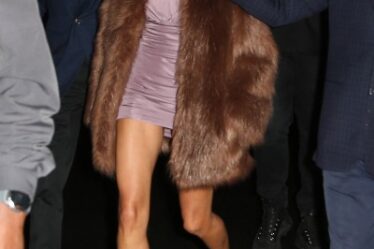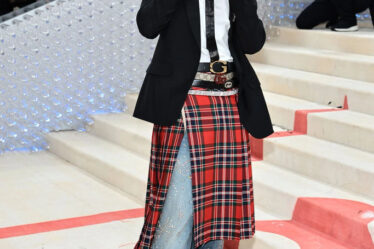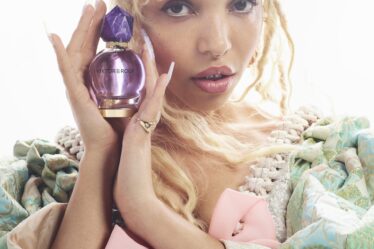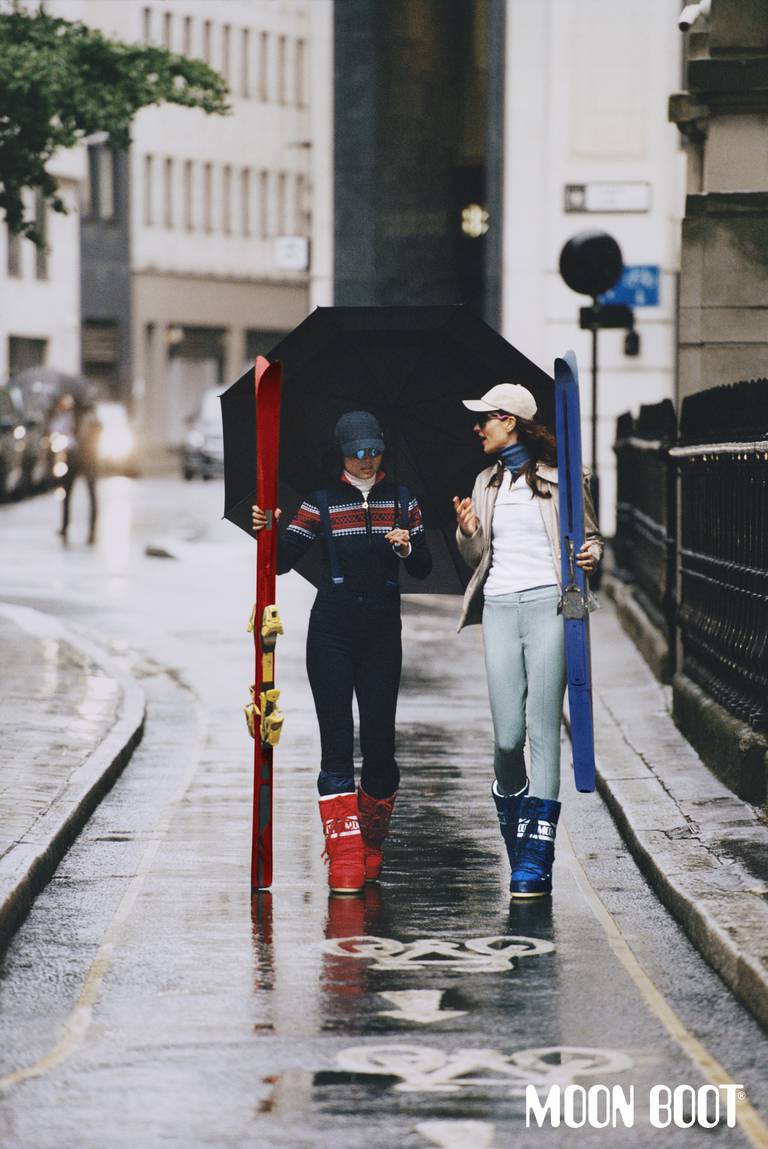
Since its founding 50 years ago, Moon Boot has built a legacy around its signature oversized boot — so much so that the shoe was included in a Louvre exhibition as a symbol of twentieth century design.
But when Mirko Massignan took over as general manager in January 2021, that legacy wasn’t propelling the brand forward: Moon Boot may have an iconic hero product, but its creative vision had stagnated.
“It was completely disconnected to what was happening in the world,” said Massignan. “The imagery was the super polished, beautiful girl in a shallow setting — so overused and not relevant today.”
Massignan set out to overhaul the image of the brand, starting a new marketing department led by head of marketing Allegra Benini, who nixed the “super polished” ski girl motif and replaced it with a number of campaigns featuring the Moon Boot styled with streetwear and shown in unexpected locations, such as a backyard pool in Los Angeles or on the streets of London. When it’s done the “beautiful girl” approach, it’s upped the star factor, enlisting famous faces like Kim Kardashian and Gigi Hadid.
So far, the formula is working. Sales are up fivefold since 2020, and the brand has won over new celebrity fans including Dua Lipa, Justin Bieber and K-pop sensation NewJeans.
The timing of its revival was astute: Just as Moon Boot was plotting its comeback, the “ugly” shoe trend had just reached the mainstream, with brands like Crocs and Hoka at the forefront. Emerging out of the pandemic, consumers were more interested in comfort than ever, and Moon Boot fit the bill. Nostalgia for all things Y2K helped, too.
But its growth wouldn’t have been possible without a recalibration, and venturing out of the après-ski category. In addition to the new campaigns, Massignan and his team pursued collaborations with brands such as streetwear label Palm Angels and sneakerhead-favourite website Highsnobiety, positioning Moon Boot as a fashion label while retaining the fun, light-hearted feeling of its core product.
“It’s just very much a moment of time, where actually they can capitalise on this much more playful approach,” said Matthew Attard Navarro, the creative director and founder of fashion-focussed creative agency ANCC Studio. “But they’re also able to really break the boundaries between what is playful and affordable and equally accessible.”
Beyond the Slopes
Moon Boot was founded in the 1960s by artist and designer Giancarlo Zanatta, whose footwear holding company Tecnica Group now includes Nordica and Lowa. The chubby snow boot emerged as an icon of mid-century fashion design, worn by wealthy skiers in Gstaad and stars like Paul McCartney in the 1970s. The iconic shoe is recognised in not only the Louvre but also the Museum of Modern Art in New York’s permanent collection.
By the time Massignan took over, its cultural relevance had waned. A resurgence in aughts was not enough to recover the brand, which had been slowly siloed into the ski category, sold in sportswear retailers. But Massignan and the rest of the team felt there was an opportunity for the brand to thrive in a fashion environment, particularly given that its eye-catching shape feels fit for social media.
“It’s kind of a surreal object because of the size and you need to be self-confident in order to to wear it, because it’s super visible,” said Massignan. “We define the community as … individuals that aren’t afraid of the spotlight.”
Like its marketing, the product itself also needed a refresh, particularly to recapture the male consumer. The brand made a Moon Boot without its signature laces, for wearers who wanted a shoe that would slip on more easily. A rain boot and sneaker boot — both in varying heights — were designed to appeal to urban-dwelling customers. Today, the brand offers 37 unisex styles, and 12 styles for women, men and kids, respectively.
Though it rolled out new variations of its core offering, the distinct, over-the-top silhouette remained the same, and in promoting this hero product, the brand leaned into the surreal, playful nature of the physical Moon Boot. This time, they wanted to adapt that approach for a more modern audience.
“The cultural relevance was something we’ve been discussing since moment one, it’s a product with such a big history,” said Benini. “We don’t want to change the heritage of the brand and lose the consumer that we already have, but we need to understand the consumer of the future and make it a bit more relevant for them.”
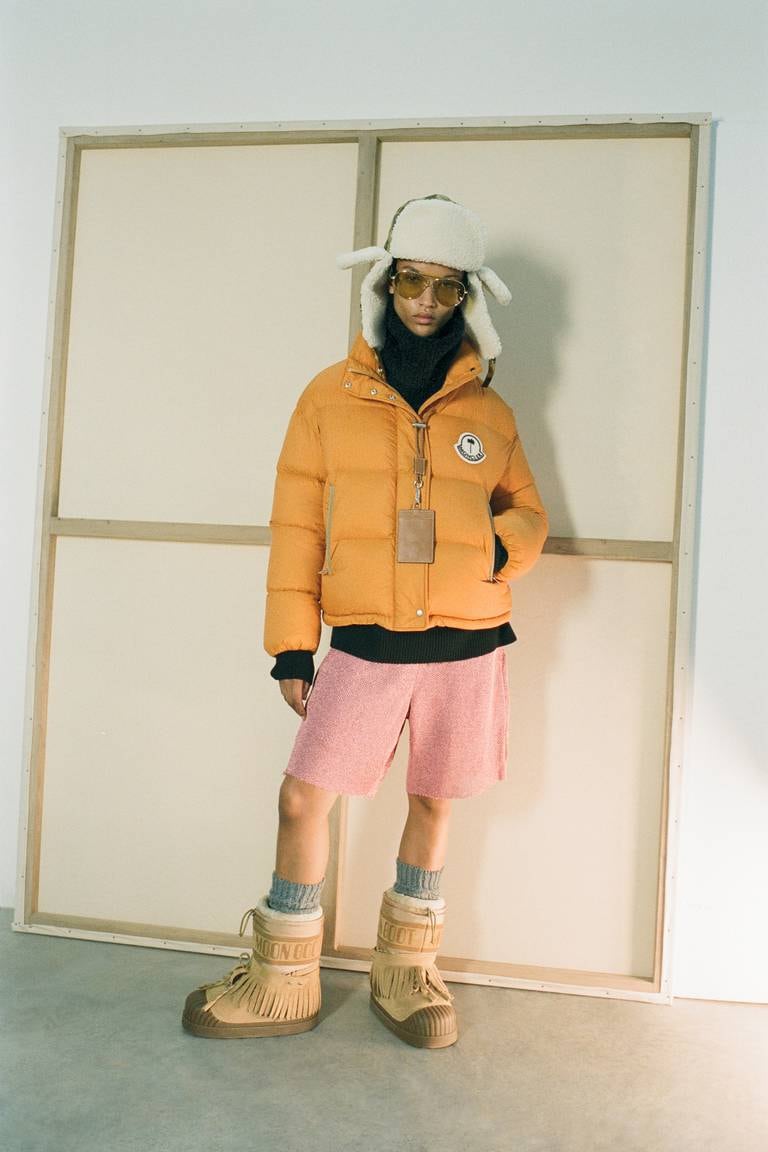
It ran campaigns featuring athletes in unconventional sports, such as the world championship-winning downhill skating team in 2021. Its Fall/Winter 2022 campaign, Icons of LA, captured real Angelenos, dressed in their actual clothes, wearing Moon Boots, in cheeky settings: a surfer sitting in a pool, wearing cargo pants and Moon Boots, reading a vintage newspaper with a front page that covered the first moon landing. The Fall/Winter 2023 campaign, “School of Life,” put Moon Boots at the centre of a cartoonish mock-up of high school students, complete with a kissing booth.
The only campaign that features Moon Boot in proximity to skiing is the Fall/Winter 2023 campaign “Snowchasers,” which shows wearers in their Moon Boots and carrying skis, but walking on the sidewalk in London, rather than on the slopes.
“We didn’t want to be too specific with fashion trends,” Benini said of the brand’s approach to its campaign strategy. “The easiest way to show the boot out of context, but to still be credible within that new context, was to dress up individuals with a super strong personality,”
But alongside those campaigns, it also rolled out other marketing materials that elevated the brand’s fashion credentials, like those starring Hadid and Kardashian, as well as a slew of collaborations. A tie-up with Netflix’s “Stranger Things” served as a nod to the brand’s heritage and popularity during the 1980s; other collaborations include Gucci Vault, the brand’s metaverse and digital fashion arm, and fellow Italian outerwear brand Moncler.
Next up, it wants to create summer-ready offerings with its first spring/summer collection in 2024, so it “can extend the brand’s shelf life,” according to Massignan, and boost sales outside of its top-performing window of November to January. The company also plans to expand in markets such as Japan and South Korea.
The challenge is to avoid falling prey to becoming a trend, as Moon Boots has in the aughts.
“We were the perfect brand for Y2K, but we don’t want to be too associated with a trend because there is a risk of becoming a fad,” Massignan said. “And when that trend is over, the brand could be over.”

